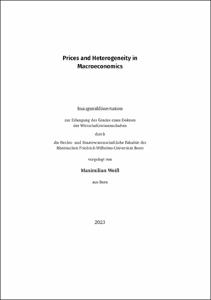Prices and Heterogeneity in Macroeconomics

Prices and Heterogeneity in Macroeconomics

| dc.contributor.advisor | Bayer, Christian | |
| dc.contributor.author | Weiß, Maximilian | |
| dc.date.accessioned | 2023-05-31T08:02:50Z | |
| dc.date.available | 2023-05-31T08:02:50Z | |
| dc.date.issued | 31.05.2023 | |
| dc.identifier.uri | https://hdl.handle.net/20.500.11811/10867 | |
| dc.description.abstract | The overarching theme of this thesis is the analysis of the effect of microeconomic heterogeneities on the response of macroeconomic quantities, especially asset prices and inflation, to specific shocks. Conceptually, microeconomic heterogeneities only matter for macroeconomic questions when certain simplifying assumptions are violated. In the first two chapters of my thesis, my co-author and I make the case that accounting for microeconomic heterogeneity is necessary to explain prevalent empirical phenomena. We focus on explaining asset price fluctuations and the price dispersion of homogeneous consumer products. Market prices are relatively easily observed, but notoriously difficult to explain. The third chapter of this thesis is a technical contribution: allowing for heterogeneity on the microeconomic level complicates the analysis of the behavior of the economic agents in the model. I propose an approximation technique to solve such models faster. In the following, I introduce each chapter in a little more detail.
In Chapter 1, we conduct a survey among German hairdressers about their reasons for adjusting their prices during the Covid-19 pandemic. The most important reason not to increase prices is the fear of losing regular customers, while the most important reasons to increase prices refer to higher costs. We find that firms who report that their customers are more understanding of their prices are more likely to increase prices. Constructing a distribution of relative prices of hairdressers, we also find that the real price rigidity that stems from low understanding is most prevalent in the center of the distribution. We rationalize these findings in the context of a search model, where customers are uncertain about the size of an industry-wide cost shock. Firms with more understanding regular customers are more able to blame higher prices on the cost shock, which keeps their customers from searching for other firms. With heterogeneity in both quality of service and production costs, firms that charge the median price are least likely to be monopolists. In Chapter 2, I show that news shocks about higher future capital returns can explain stock price-booms and subsequent -busts in a two-asset, heterogeneous agent New Keynesian model. The portfolio choice between liquid assets (like stocks) and illiquid capital is key, as it allows for a time-varying illiquidity premium. Upon the news, capital-rich households accept to hold more illiquid capital at a lower premium, in anticipation of higher future returns on it. This increases their consumption risk, and causes stock prices to rise. After the boom, capital-rich households trade capital for liquid assets in order to self-insure against idiosyncratic income shocks, which increases the illiquidity premium, and causes stock prices to fall. Novel evidence from survey data on portfolio choices of capital-wealthy households during stock price boom-bust cycles supports the key mechanism of the model. In Chapter 3, I discuss the problem of the efficient computation of the second order perturbation of a state-space system with heterogeneous, forward-looking agents. I find that the nonlinear effect of the distribution constitutes the main share of the computational burden. I propose a way to split up the nonlinearity in a direct and an indirect component. Abstracting from the indirect nonlinear effect speeds up the computation and yields a suitable approximation of the system dynamics in the short run. | en |
| dc.language.iso | eng | |
| dc.rights | Namensnennung 4.0 International | |
| dc.rights.uri | http://creativecommons.org/licenses/by/4.0/ | |
| dc.subject | survey evidence | |
| dc.subject | price dispersion | |
| dc.subject | search models | |
| dc.subject | information asymmetry | |
| dc.subject | customer market | |
| dc.subject | learning from prices | |
| dc.subject | real rigidities | |
| dc.subject | news shocks | |
| dc.subject | stock price booms | |
| dc.subject | time-varying discount rates | |
| dc.subject | HANK | |
| dc.subject | numerical methods | |
| dc.subject | perturbation | |
| dc.subject | nonlinearities | |
| dc.subject | incomplete markets | |
| dc.subject.ddc | 330 Wirtschaft | |
| dc.title | Prices and Heterogeneity in Macroeconomics | |
| dc.type | Dissertation oder Habilitation | |
| dc.publisher.name | Universitäts- und Landesbibliothek Bonn | |
| dc.publisher.location | Bonn | |
| dc.rights.accessRights | openAccess | |
| dc.identifier.urn | https://nbn-resolving.org/urn:nbn:de:hbz:5-70967 | |
| ulbbn.pubtype | Erstveröffentlichung | |
| ulbbnediss.affiliation.name | Rheinische Friedrich-Wilhelms-Universität Bonn | |
| ulbbnediss.affiliation.location | Bonn | |
| ulbbnediss.thesis.level | Dissertation | |
| ulbbnediss.dissID | 7096 | |
| ulbbnediss.date.accepted | 16.05.2023 | |
| ulbbnediss.institute | Rechts- und Staatswissenschaftliche Fakultät / Fachbereich Wirtschaftswissenschaften : Institut für Makroökonomik und Ökonometrie | |
| ulbbnediss.fakultaet | Rechts- und Staatswissenschaftliche Fakultät | |
| dc.contributor.coReferee | Hintermaier, Thomas | |
| ulbbnediss.contributor.gnd | 1292500565 |
Dateien zu dieser Ressource
Das Dokument erscheint in:
-
E-Dissertationen (287)




